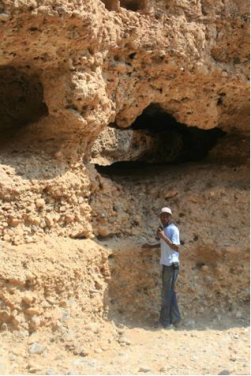 Image
Image:
Alluvial fan conglomerates exposed on the walls of Sesriem Canyon, in Namibia.
The Dust Working Group is keen to stimulate debate and research on dust from geological sources (e.g. soil erosion, volcanic activity, mineral extraction and wastes) in terms of sources, pathways and receptors including human and ecosystem health. Activities of the group will include a number of symposia leading, form the first time, to a book on the relevance of geological sources to planning, management and the well-being of society. Already, links have been established with international unions for volcanologists and soil scientists
A series of successful meetings, workshops, presentation and debates took place during the IUGS-GEM annual meeting. Here, particular attention was draw to the current status of the rapidly expanding mining industry in Namibia. Mining and minerals are major contributors to the Namibian economy and are envisaged to continue to contribute to future growth and developments of the country. The mineral commodities current being produced include; gold, placer diamonds along the Atlantic coast, sediment hosted base metals, sedex deposits (copper, lead, zinc), manganese and rare earths and some carbonatites are also mined. There is also currently a ‘Uranium Rush’ whereby the exploration, mining and processing of uranium ores have experienced unprecedented growth in recent years. However, consistent with many other mining countries in Africa (and other parts of the world) the past mining and processing of minerals has resulted in damage and degradation to the environment and to peoples lives in parts of Namibia, which has now stimulated careful environmental impacts assessments on, and design of mitigation measures for, new developments.